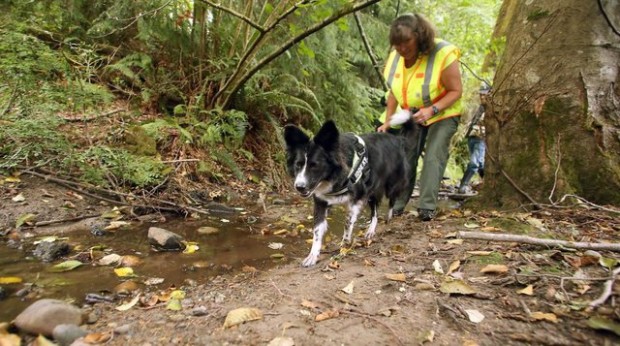Published online: Monday, Sept. 8, 2014
BREMERTON — Molly and Kona sniffed Monday through Enatai Creek in East Bremerton, searching for what no one wants in their water and every dog loves to stop and smell — poop.

Molly leads handler Gwen Jones on Monday along Enatai Creek in Bremerton. (Meegan Reid / Kitsap Sun)
The two dogs, that are with Environmental Canine Services, are helping the Kitsap Public Health District search for stormwater pollution, specifically human feces contamination, that will flow into local rivers, lakes and Puget Sound, according to Stuart Whitford, the health district’s water pollution identification and correction program manager.
It is the first time dogs have been used to check for water contamination in Kitsap County.
On Monday, the dogs sniffed out sites in East Bremerton, Central Kitsap and North Kitsap. If the dogs find a contaminated water source, they work their way up stream with their handlers to locate the source, according to Karen Reynolds, Environmental Canine Services president.
“We heard these dogs were successfully used in California and the East Coast, so we wanted to see if it could help us identify sources here. And also, if we can prioritize those drainages impacted by sewage then it will help us be more efficient in the field,” Whitford said.
The health district tests samples from shorelines of creeks, lakes and bays throughout the year for bacteria. Every shoreline is sampled twice every four years, once during the dry season and again in the wet season, according to environmental health specialist Kimberly Jones. The health district is separate from the county and a majority of its funds come through Clean Water Kitsap, a partnership program with the county.
While waiting for test results takes time, the sniffing canines can speed up the process of searching for contamination and its source.
“The dogs are useful because if they can alert to something in the field then it will be quicker for us to investigate it to the source,” Whitford said. “The bacteriological tests, we’ll get those back within a few days. Of course, the dog assessment is immediate.”
Bacteria tests show feces or E. coli is present, but it doesn’t differentiate between humans and animal feces. The dogs are trained to only signal for human feces by laying down.
Although the dogs didn’t signal for human feces in Enetai Creek, they were laying down all along Washington Avenue’s storm drains Monday, according to Jones.
“They were on to something,” she said.
The search for the source was called off as traffic picked up from a ferry arrival, making it too dangerous for the handlers and dogs to be in the street. The search might be picked up Tuesday if there is enough time, Jones said. The dogs and their handlers are scheduled for two days in Kitsap County.
The health district has suspected there were contamination issues along Washington Avenue’s storm drains since water tests along the beach where the water dumps out have shown high levels of E. coli, according to Jones. The E. coli investigation threshold is 400 bacteria colonies parts per 100 milliliters, while the beach samples are into the thousands, Jones said. When colony numbers reach above 400, the health district goes back to investigate a potential contamination and its source.
There is no swimming or fishing for shellfish around the contamination site, but it is an issue to resolve, Jones said.
Finding the source of contamination is where the dogs can help. They can quickly locate a source, which is often a leaking septic tank, cracked sewage line or a sewage line that has been accidentally or illegally connected to a stormwater drainage system, according to Reynolds.
The health district also is sending water samples to the University of Washington’s Center for Urban Waters in Tacoma, where they will be tested for chemicals likely to be in human feces, such as caffeine and over-the-counter medications, as well as their digestive byproducts, Whitford said. Results can take up to a month to be finished and returned to the health district.
The tests will help determine the most effective means of tracing feces contaminated water, Whitford said.
Chemical testing can be expensive compared to the bacteria tests. Bacteria tests cost $10 to $15 per sample test, while chemical testing can ranging from $300 to $700 a sample, Jones said.
More samples are recommended for the less expensive chemical tests, which can recommend as many as 100 samples for each site, according to Shawn Ultican, the health district’s senior environmental health specialist.
“Our concern is public health. People walk on these beaches. Kids play in the water,” Ultican said. “We don’t want people to get sick.”
